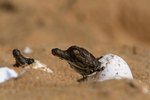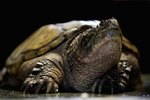
Crocodiles are large, semi-aquatic reptiles with long, pointy snouts and brown, gray or green scales. Different species are found all over the world, from the southeastern U.S. in Florida to Queensland, Australia. Like other cold-blooded reptiles, crocodiles vary their behaviors depending on their habitat's climate.
On the Map
Crocodiles are naturally located on every continent except Europe and Antarctica. These large reptiles are commonly found in countries that border the equator, since this area is known for its varying wet and dry seasons. Since crocodiles are cold-blooded, their behaviors depend on their environment and its climate. Different species of crocodiles function better in dry climates, while others prefer to be active in wet climates.
Crocodile Abodes
Crocodiles live in both freshwater and brackish, or slightly salty, environments. Such habitats include estuaries, grasslands, rivers, marshes, streams, rain forests, ponds and lakes. These reptiles sometimes live in different habitats depending on their size. For example, larger New Guinea crocodiles live in river channels, while smaller ones are found in flooded grasslands. The differences in water levels among the seasons also affects where crocodiles live and hunt. For instance, American crocodiles dig burrows when water levels are low. Burrow entrances are built partially underwater. These burrows protect the crocodiles from disagreeable weather and give them a safe, quiet place to rest. Morelet's crocodiles also dig burrows during dry seasons, where they remain in a state of dormancy until the start of the next wet season.
Climate and Thermoregulation
Crocodiles depend on their environment to control their body temperature. This is known as thermoregulation. When cold, crocodiles lie out in the sun to warm up. Since crocodiles don't sweat, they instead keep their mouths open when sunning themselves. This is known as "gaping" and it helps keep their body temperature around 77 degrees Fahrenheit. Sunning also helps increase the rate of digestion, since energy can be devoted to their metabolism instead of to keeping the body warm. When overheated, crocodiles saunter down to water to lower their body temperature. After spending all day lounging around in the sun warming up, crocodiles become active at night. During this time, they breed and hunt.
Reproductive Routines
Climate affects the breeding routines of various species of crocodiles. For example, in New Guinea crocodiles, those living in northern Papua New Guinea breed from June to December, which is the dry season. Southern New Guinea crocodiles breed from December to March, which is the wet season. In Central America, Morelet's crocodiles mate and lay eggs during the wet season. Alternatively, Johnstone River crocodiles, who are native to Australia, lay their eggs in the dry season. Johnstone River crocodile embryos' sex depends on the temperature of their habitat. Females develop in high and low temperatures, while moderate temperatures produce male young.
References
- University of Michigan: Crocodylus acutus
- University of Michigan: Crocodylus porosus
- Patricia and Phillip Frost Museum of Science: American Crocodile
- Queensland Government—Department of Environment and Heritage Protection: Crocodiles
- U.S. Fish and Wildlife Service: American Crocodile [PDF]
- University of Michigan: Crocodylus johnsoni
Resources
Photo Credits
-
Anup Shah/Digital Vision/Getty Images
Writer Bio
Amanda Williams has been writing since 2009 on various writing websites and blogging since 2003. She enjoys writing about health, medicine, education and home and garden topics. Williams earned a Bachelor of Science in biology at East Stroudsburg University in May 2013. Williams is also a certified emergency medical technician.




